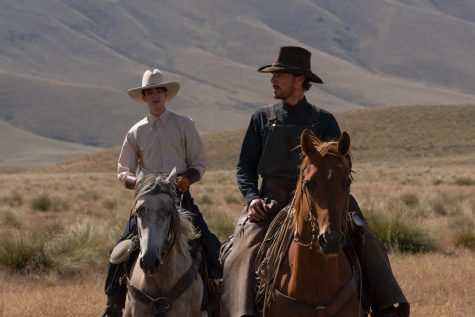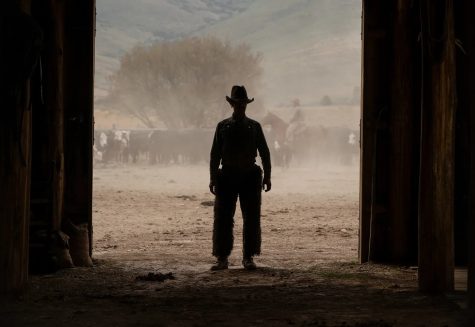‘The Power of the Dog’: A mastery of characters
March 27, 2022
“I wanted nothing more than my mother’s happiness. For what kind of man would I be if I did not help my mother? If I did not save her?”
The Academy Award-nominated film “The Power of the Dog,” directed by Jane Campion, opens with a narration by frail and unassuming Peter (Kodi Smit-McPhee). Peter’s words are more than an introduction to his character. It introduces the film’s underlying motif: What does it mean to be a man?

The film, nominated for Best Picture, Best Original Score, and 10 other categories at the 94th Academy Awards, is based on a 1967 novel by Thomas Savage, which revolves around Phil Burbank (Benedict Cumberbatch), his brother George Burbank (Jesse Plemons) and new wife Rose Gordon (Kirsten Dunst) and son Peter in 1925 rural Montana.
For decades, Phil has raised cattle alongside his brother on their family’s Montana ranch. From the beginning, however, it is clear that the brothers have stark differences. Phil is controlling and brutal, while George is a kinder and gentler soul.
The relationship between Phil and George changes when George marries Rose, a widow with a teen son. Rose and her son, Peter, come to live with Phil and George on their ranch. Phil, though, views Rose as an intruder in his relationship with George and sets out to psychologically torment her. As a result of Phil’s malevolent behavior, Rose’s mental health begins to decline, drawing Peter into the picture as his mother’s protector.
On the surface, “The Power of the Dog” is slow and drawn out. It hardly moves temporally and spatially, but there is tremendous depth in each of the relationships between the film’s main characters. The highlight of the film is the exploration of Phil and Peter’s characters. Phil’s macho exterior masks a longing for companionship, and Peter’s effeminate mannerisms hide his deeper cunning. As the relationship between Phil and Peter progresses, different sides of each character are revealed leaving the viewer unsettled.

Cumberbatch and Smit-McPhee deliver impressive performances, both portraying their characters in strikingly cogent ways. Each manages to cohesively integrate ideas of masculinity and femininity within their roles, making the actions they take as the film progresses even more nuanced.
“The Power of the Dog” tells a seemingly cliche story about becoming a man, but instead of the mentor-mentee relationship that Phil, and viewers of the cowboy western, expect, Campion flips the trope on its head. The extent of Peter’s manipulation to protect his mother is not revealed until the end. Adding to the acting are layers of parallelism that Campion masterfully inserts, which both captivate and add to the brilliance of the film.
The ensemble of piano, strings, winds and brass composed by Jonny Greenwood is a dark and disturbing score, which adds to the viewers general feeling of unease. One is intensely aware of the changes in music as it hints what the next scene will be, and the music only compliments the visual elements, without overshadowing other aspects of the film.
The cherry on top is the scenic landscape the film’s cinematography spotlights. Although the story is set in Montana, “The Power of the Dog” was shot in New Zealand. Cinematographer Ari Wegner perfectly captures the emotions each scene in the film evokes with the alternations between landscapes of lush grass and crystal blue ponds, to dark shadowed hills and jagged cliffs.
Although chilling, “The Power of the Dog” is a cleverly crafted film with each element — the storyline, acting and cinematography — working in perfect harmony. The film explores the nuances of relationships, and challenges stereotypical views of what being a man means. The motifs together with its superb execution make “The Power of the Dog” well deserving of its 12 Oscar nominations.
“The Power of the Dog”
2 hours 5 minutes
Rated R for some nudity, cattle castration, language and violence
Starring Benedict Cumberbatch, Kodi Smit-McPhee, Kirsten Dunst, Jesse Plemons
Directed by Jane Campion








![A protester in a chicken suit wearing a taco hat with the words “Cluck Trump” at the “No Kings” Democracy Fair in Palo Alto on Saturday. Protestor Mary Chan said she and her husband are horrified at the state of science and medicine in America. “What he [Trump] is doing by defunding scientific research is destroying our academic medical centers, and he’s [Trump] bankrupting rural medical centers,” Chan said. “We will have lasting negative impacts on American health for decades.”](https://palyvoice.com/wp-content/uploads/2025/10/11562FFE-9912-4152-BB01-582426B52ECB_1_105_c-225x300.jpeg)